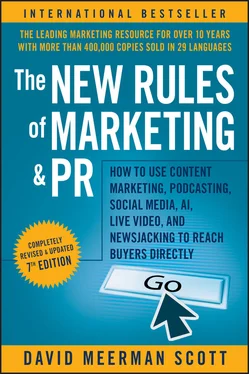Guess what? The popular people on the cocktail circuit make friends. People like to do business with people they like. And they are eager to introduce their friends to one another. The same trends hold true in social media. So go ahead and join the party. But think of it as just that—a fun place where you give more than you get. Of course, you can also do business there, but the kind you do at a cocktail party and not at the general store. What you get in return for your valuable interactions are lasting friendships, many of which lead to business opportunities.
This chapter is an introduction to the concepts of social media. In subsequent chapters, I go into much greater detail about blogs ( Chapters 5and 15), video ( Chapters 6and 17), and social networking ( Chapter 14).
“Upgrade to Canada” Social Program Nabs Tourists from Other Countries
The travel market is crowded. Consumers have lots of places to find information about places to visit. In this environment, the best content and the companies that are most engaged with social networks can win the day.
Canada Tourism engaged travelers with a terrific social networking program called “Upgrade to Canada.” Representatives from Canada Tourism intercepted travelers at the Frankfurt and Lyon airports and tried to persuade them to switch their holiday plans, on the spot, to visit Canada instead. People had only a few minutes to consider the offer. Fortunately, many of them were open to the serendipity of a real-time travel change, and they spontaneously changed their travel destinations.
Canada Tourism then created real-time social content about the travelers and their experiences once they arrived in Canada, and the tourists themselves eagerly shared on their own social networks, including Twitter, YouTube, and Facebook.
“The results were extraordinary,” says Siobhan Chrétien, regional managing director for Canada Tourism. “Not only were we able to share firsthand the travelers’ stories with the world, but online we received further upgrades from over 100 countries by travelers who switched to Canada.” Social networking drove awareness of Canada as a destination. Canada’s share among competitive destinations increased by a remarkable 21.5 percent.
I love the idea of requiring people to make a decision in just a few minutes. The real-time nature of how people then share their experience separates “Upgrade to Canada” from other social media campaigns from tourism organizations.
“No matter how sexy a destination is, promoting a country for tourism purposes has its challenges,” Chrétien says, “especially with the world now being a smaller place with many travel options and competing experiences and destinations. The traveler of today and of the future has a vast array of options. It is not enough to run slick ad campaigns or hope that price alone will drive a sale and convert a tourist. The traveler needs to be inspired, motivated, influenced, and in some cases convinced on the spot that the time is now to make the trip!”
Smart organizations understand this new world and build a buying process around the realities of independent research and the power of social networks. Instead of generic information dreamed up by an advertising agency, they tell authentic stories that interest their customers. Instead of selling, they educate through online content. Instead of ignoring those who have already made a purchase, they deliver information at precisely the moment customers need it.
It’s not just travel destinations that can benefit from social engagement. Every market is influenced by what people are saying on social networks: the good, the bad, and, in some cases, nothing.
Social Networking and Agility
Social networking allows companies to communicate instantly with their existing and potential customers. That Canada Tourism built an entire awareness campaign around real-time strategies shows the power of instant communications. Yet many organizations don’t respond to people quickly on social networks.
I’m a “Pro” user of the Hightail file sharing and storage service. I’ve been a loyal customer since January 2009, paying more than $100 a year for my premium services. I received an email offer from Hightail with the subject line “Complete your list with our great discount.” The offer promised if I would “Upgrade to Hightail Professional” that day, I’d get 50 percent off the annual subscription price. Hightail subscription plans had confusing names: Hightail Professional is an upgrade from the Hightail Pro service I was using at the time.
The offer sounded good, so I clicked the “Get the deal” button.
However, when I logged into my Hightail account to complete the transaction, I got a nasty error message: “Your account does not meet the prerequisites for using this SKU code.”
This was frustrating, so I tweeted a message to Hightail (@HightailHQ) and waited for a response. And I waited some more. When I didn’t hear from them for three days, I chose to look into competing product offerings from other companies.
When responding to a negative comment in a social network, it is best to reply quickly, honestly, and in the same medium.
Not responding quickly is a huge missed opportunity. When you reply to user messages in real time, not only do you keep the customer up to date, but you also show the world through your public feed that you’re engaged. When customers are happy, they keep their product longer, they spend more money over time, and they share their happiness with others, either in person or on social networks. Hightail missed an opportunity to engage with me. And there’s no doubt that some of my more than 125,000 Twitter followers noticed Hightail’s lack of interest in responding to a customer.
The team at Hightail did finally get back to me and worked with me to solve the problem. I remain a customer, but it wasn’t a pleasant experience.
Contrast the long delay at Hightail with an experience around the same time with @JetBlue. In this case, I received a reply in just two minutes. Talk about speed! No wonder JetBlue has nearly two million followers on Twitter—it communicates in real time.
When Social Networking Doesn’t Work: The Cannabis Business in America
In this chapter and throughout the book I talk a lot about how social networking is a great way to reach buyers. But occasionally a market exists where social networking is not appropriate.
As American voters pass referenda permitting the use of medical marijuana and legalizing it for recreational use, many businesses have cropped up to service this emerging market. As I write this, 33 U.S. states have legalized medical marijuana, while 11, plus Washington, D.C., have legalized recreational use. However, because it is still illegal at the federal level, laws often forbid the use of social networking to market products from this fledgling industry.
“Marijuana from a marketing perspective is fascinating, because you can’t market in the usual way. It’s illegal,” says Larry Schwartz, president of Cannabiz Media, the most comprehensive source for U.S. marijuana licensing information. Data from Cannabiz Media helps journalists, regulators, researchers, businesspeople, and investors understand and operate confidently in the evolving U.S. marijuana marketplace.
When Schwartz first started to market his business, he tried to run Google AdWords and Facebook Ads but was quickly rejected by both companies. Twitter and Instagram also forbid such advertising.
Google’s representative emailed Schwartz: “Thank you for calling the Google AdWords Welcome center. I looked into and tried to see if there was a way that I could help you to be able to advertise with AdWords. However I was unsuccessful in my pursuit. Google won’t allow your website to be advertised with AdWords. While your Business model is solid and company is legal it does fall into Dangerous products or services. With that being said, your ads can show organically. The Search Console will assist you [ sic ] Organic ad results.”
Читать дальше












